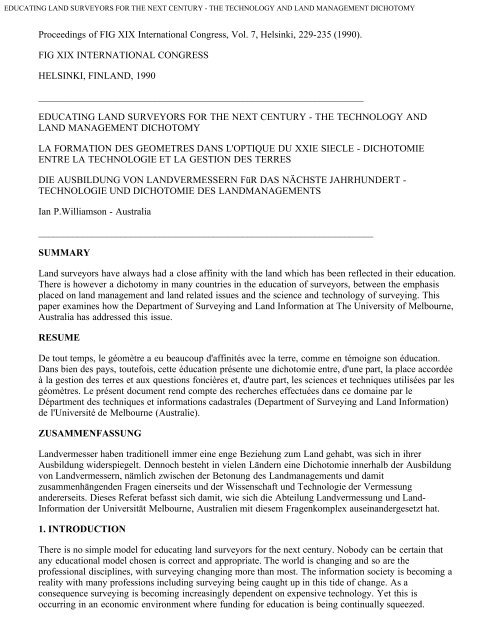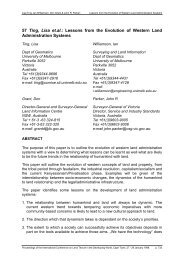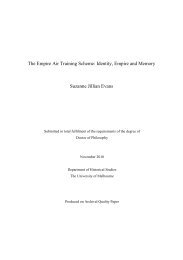Educating land surveyors for the next century: the technology and ...
Educating land surveyors for the next century: the technology and ...
Educating land surveyors for the next century: the technology and ...
Create successful ePaper yourself
Turn your PDF publications into a flip-book with our unique Google optimized e-Paper software.
EDUCATING LAND SURVEYORS FOR THE NEXT CENTURY - THE TECHNOLOGY AND LAND MANAGEMENT DICHOTOMYwere at <strong>the</strong>ir peak. The last decade has seen a swing back towards a <strong>l<strong>and</strong></strong> focus with particular emphasison <strong>the</strong> management of spatial data in <strong>the</strong> broadest sense <strong>and</strong> <strong>l<strong>and</strong></strong> in<strong>for</strong>mation management. However <strong>the</strong>greatest emphasis in all programs is still <strong>and</strong> will most probably remain, measurement science <strong>and</strong> <strong>the</strong>management of spatial data. This is <strong>the</strong> underlying foundation on which <strong>the</strong> <strong>l<strong>and</strong></strong> related studies build.The dichotomy between measurement science <strong>and</strong> <strong>l<strong>and</strong></strong> related studies becomes increasingly evident whenattempting to design education programs <strong>for</strong> <strong>the</strong> <strong>next</strong> <strong>century</strong>. With <strong>the</strong> expansion of knowledge,individual courses in programs are continually under pressure as to <strong>the</strong>ir relevance <strong>and</strong> necessity,particularly from <strong>the</strong> science <strong>and</strong> computing areas. L<strong>and</strong> related studies are easy to reduce, while at <strong>the</strong>same time <strong>the</strong> environment, natural resource management <strong>and</strong> <strong>l<strong>and</strong></strong> management (especially in urbanareas) are becoming increasingly important.The difficulty arises in not knowing what are <strong>the</strong> requirements of <strong>the</strong> surveying profession or <strong>the</strong> broadneeds of <strong>the</strong> community <strong>for</strong> surveying expertise in <strong>the</strong> year 2000. What is certain however is that <strong>the</strong>courses we teach now <strong>and</strong> during <strong>the</strong> <strong>next</strong> decade will influence to a large extent <strong>the</strong> role <strong>and</strong> skills of <strong>the</strong>profession in <strong>the</strong> future. If <strong>the</strong> educators don't "get it right", <strong>the</strong>y will be responsible <strong>for</strong> undermining <strong>the</strong>future role of <strong>the</strong> surveying profession while at <strong>the</strong> same time not serving <strong>the</strong> communities needs.3. CONSIDERATIONS IN DESIGNING A LAND SURVEYING DEGREE PROGRAMConsidering <strong>the</strong> changing world <strong>and</strong> <strong>the</strong> obvious uncertainties facing <strong>the</strong> surveying profession, it isimportant to maintain flexibility as well as a good foundation of basic principles in any surveyingprogram. Surveying programs should provide a range of career opportunities in measurement science(obviously including <strong>the</strong> range of surveying areas such as engineering surveying, hydrographic surveying,geodetic surveying etc), computing, <strong>l<strong>and</strong></strong> <strong>and</strong> geographic in<strong>for</strong>mation systems, <strong>l<strong>and</strong></strong> management <strong>and</strong>administration, cadastral surveying <strong>and</strong> mapping, <strong>l<strong>and</strong></strong> development, environmental management <strong>and</strong>natural resource management. Surveyors should not necessarily be <strong>the</strong> experts in all <strong>the</strong>se areas but it ishighly desirable that <strong>the</strong>y have sufficient background, confidence <strong>and</strong> skills to move into <strong>the</strong>se areas, inmany cases with <strong>the</strong> addition of fur<strong>the</strong>r studies.In designing surveying programs <strong>for</strong> <strong>the</strong> future <strong>the</strong>re are a few important considerations:a. Measurement science as a discipline <strong>for</strong> <strong>surveyors</strong> is becoming more cohesive. Programs in <strong>the</strong>future will not be dominated by <strong>the</strong> three measurement science streams of geodesy,photogrammetry <strong>and</strong> plane surveying as separate entities to <strong>the</strong> same extent as in <strong>the</strong> past.Measurement science will however continue to be <strong>the</strong> major focus <strong>for</strong> <strong>surveyors</strong> but in a morecohesive <strong>for</strong>m.b. A balance must be struck between <strong>the</strong> sciences, measurement science <strong>and</strong> <strong>the</strong> management ofspatial data, <strong>and</strong> <strong>l<strong>and</strong></strong> management <strong>and</strong> an underst<strong>and</strong>ing of <strong>the</strong> environment. This is essential inorder to maintain <strong>the</strong> <strong>surveyors</strong>' competitive edge. (c) Technology has imposed necessary changeson surveying programs. For example <strong>the</strong> impact of Doppler satellite positioning <strong>and</strong> <strong>the</strong> GlobalPositioning System (GPS) have necessitated fundamental changes to surveying practices, <strong>the</strong> leastnot being a reduction <strong>and</strong> in some cases a disappearance of disciplines such as classical astronomy<strong>and</strong> some of <strong>the</strong> more classical surveying techniques. Analytical photogrammetric instruments havehad a similar impact on photogrammetry as has electronic distance measurement (EDM) onmeasurement practices. Arguably <strong>the</strong> biggest technological impact has been to computing with <strong>the</strong>development of "field to office" systems becoming <strong>the</strong> norm. Overall one of <strong>the</strong> significant impactsof <strong>the</strong>se technologies on surveying education is a reduction in <strong>the</strong> expertise required <strong>for</strong> traditionalfield surveying techniques. It is a concern to many in <strong>the</strong> profession to see non-<strong>surveyors</strong> usingEDM <strong>and</strong> GPS.c. The above changes <strong>and</strong> <strong>the</strong> need <strong>for</strong> flexibility has placed an increasing emphasis on basicprinciples <strong>and</strong> in particular <strong>the</strong> basic sciences. In particular <strong>the</strong>re is an ever increasing requirement
EDUCATING LAND SURVEYORS FOR THE NEXT CENTURY - THE TECHNOLOGY AND LAND MANAGEMENT DICHOTOMY<strong>for</strong> a greater amount of computer science in surveying programs.d. While it is essential to design programs <strong>for</strong> <strong>the</strong> future, it is just as important that <strong>the</strong> presentdem<strong>and</strong>s of <strong>the</strong> profession, industry <strong>and</strong> society are served. The requirements of Boards ofSurveyors in Australia <strong>for</strong> example still need to be fully addressed albeit educators should be tryingto influence <strong>the</strong> requirements of such boards to reflect future practices <strong>and</strong> to discard outdatedrequirements.e. The <strong>surveyors</strong> of <strong>the</strong> future will have to be skilled in <strong>the</strong> management of spatial data in <strong>the</strong> broadestsense. They should be <strong>the</strong> professionals with <strong>the</strong> technical expertise to underst<strong>and</strong> <strong>the</strong> operation <strong>and</strong>data requirements of <strong>l<strong>and</strong></strong> <strong>and</strong> geographic in<strong>for</strong>mation systems.f. Surveyors of <strong>the</strong> future should loose <strong>the</strong>ir "backwoodsman" image. They should become goodmanagers <strong>and</strong> entrepreneurs in applying <strong>and</strong> marketing <strong>the</strong>ir skills.4. THE UNIVERSITY OF MELBOURNE, AUSTRALIA - A CASE STUDYThe Department of Surveying <strong>and</strong> L<strong>and</strong> In<strong>for</strong>mation is located in <strong>the</strong> Faculty of Engineering at TheUniversity of Melbourne. Surveying was first taught in engineering with <strong>the</strong> appointment of <strong>the</strong> firstsurveying lecturer in 1862. The surveying degree was introduced in 1953.In <strong>the</strong> early 1980's <strong>the</strong> Department decided to move its emphasis from <strong>the</strong> traditional geodesy,photogrammetry <strong>and</strong> plane surveying focus to a greater emphasis on <strong>l<strong>and</strong></strong> in<strong>for</strong>mation studies <strong>and</strong> <strong>the</strong>management of spatial in<strong>for</strong>mation in <strong>the</strong> broadest sense. At <strong>the</strong> graduate studies <strong>and</strong> research levels <strong>the</strong>Department wished to consolidate its activities in <strong>l<strong>and</strong></strong> in<strong>for</strong>mation studies <strong>and</strong> in its existing area ofexcellence of high precision measurement, particularly in <strong>the</strong> photogrammetric area. It wanted to alsoexp<strong>and</strong> its already considerable linkages with industry.The Department developed a five year plan which it commenced in 1986 to move in this direction. Amajor component of this plan was <strong>the</strong> implementation of a new undergraduate program. In order toachieve this objective <strong>the</strong> Department did a review of professional <strong>and</strong> community needs, at that time <strong>and</strong>in <strong>the</strong> future, attempted to assess future job prospects <strong>for</strong> <strong>surveyors</strong>, attempted to determine <strong>the</strong> type ofprofessional required to serve those needs <strong>and</strong> fill those jobs, determined <strong>the</strong> skills required to meet thoseneeds <strong>and</strong> <strong>the</strong>n attempted to design a surveying degree which would provide <strong>the</strong> necessary education.Considering <strong>the</strong> new direction of <strong>the</strong> Department towards <strong>l<strong>and</strong></strong> in<strong>for</strong>mation management it became evidentthat <strong>the</strong> profession, industry <strong>and</strong> community required two programs; a modified four year Bachelor ofSurveying program <strong>and</strong> a five year program with a major emphasis on computer science leading to <strong>the</strong>award of two degrees, namely <strong>the</strong> Bachelor of Surveying <strong>and</strong> <strong>the</strong> Bachelor of Science (ComputerScience). These two programs were introduced in 1989 with a combined intake of 45 students. One of <strong>the</strong>hardest tasks however in designing <strong>the</strong>se two programs was to get <strong>the</strong> right balance between basicsciences, measurement science <strong>and</strong> <strong>l<strong>and</strong></strong> related studies.In recognition of <strong>the</strong> new direction <strong>and</strong> activities in <strong>l<strong>and</strong></strong> in<strong>for</strong>mation management, <strong>the</strong> Departmentincluded "L<strong>and</strong> In<strong>for</strong>mation" in its name in 1987, <strong>and</strong> was designated in 1988 as a Centre of Excellenceby <strong>the</strong> international Institute of L<strong>and</strong> In<strong>for</strong>mation based in Washington DC. The primary focus of <strong>the</strong>Department however still is <strong>and</strong> will remain "surveying", as reflected in <strong>the</strong> name of <strong>the</strong> department <strong>and</strong><strong>the</strong> degree.5. THE UNDERGRADUATE PROGRAMSThe four year Bachelor of Surveying program was designed around <strong>the</strong> principles set out above. Theprogram was split into six streams reflecting <strong>the</strong> six major thrusts of <strong>the</strong> program. The streams <strong>and</strong> <strong>the</strong>percentage of time allocated to each stream is set out below:MATHEMATICS AND SCIENCE 20%COMPUTER STUDIES 15%
EDUCATING LAND SURVEYORS FOR THE NEXT CENTURY - THE TECHNOLOGY AND LAND MANAGEMENT DICHOTOMYSURVEYING SCIENCE 27%LAND INFORMATION TECHNOLOGY 9%LAND MANAGEMENT 16%PROFESSIONAL STUDIES 13%"Ma<strong>the</strong>matics <strong>and</strong> science" comprises ma<strong>the</strong>matics, physics, statistics <strong>and</strong> electronics."Computer studies" comprises basic computer science subjects, computer systems <strong>for</strong> <strong>surveyors</strong> <strong>and</strong>computer graphics subjects."Surveying Science" comprises plane, engineering <strong>and</strong> hydrographic surveying, geodesy, photogrammetry<strong>and</strong> geodetic surveying."L<strong>and</strong> in<strong>for</strong>mation <strong>technology</strong>" comprises cartography, spatial analysis, remote sensing, <strong>and</strong> <strong>l<strong>and</strong></strong> <strong>and</strong>geographic in<strong>for</strong>mation systems."L<strong>and</strong> management" comprises <strong>l<strong>and</strong></strong> law, cadastral surveying, <strong>l<strong>and</strong></strong> development, <strong>and</strong> aspects of <strong>l<strong>and</strong></strong>management, <strong>l<strong>and</strong></strong> administration, <strong>l<strong>and</strong></strong> economy, town planning, ecology, geology <strong>and</strong> environmentalassessment."Professional studies" comprises written, verbal <strong>and</strong> graphic communication, introduction to engineering,economics, project planning <strong>and</strong> a minor <strong>the</strong>sis.The combined surveying/computer science degree over five years has basically <strong>the</strong> same program asabove with some reorganization, however it has a strong computer science stream through <strong>the</strong> first fouryears with Year 5 being mainly advanced computer science aimed at in<strong>for</strong>mation <strong>technology</strong> <strong>and</strong> <strong>the</strong>management of spatial data.It is recognized that both <strong>the</strong>se programs are new <strong>and</strong> will need modification over <strong>the</strong> <strong>next</strong> few years.However <strong>the</strong> overall structure is now in place such that improvement is relatively easy. The Departmentbelieves <strong>the</strong> new programs achieve its objectives by providing a sound basis in <strong>the</strong> sciences, a goodbalance between surveying science <strong>and</strong> <strong>l<strong>and</strong></strong> management, provide flexibility <strong>and</strong> options <strong>for</strong> employment<strong>and</strong> serve <strong>the</strong> present needs of <strong>the</strong> surveying, mapping <strong>and</strong> <strong>l<strong>and</strong></strong> in<strong>for</strong>mation industry.6. THE GRADUATE PROGRAMThe undergraduate programs are designed to support <strong>the</strong> graduate program particularly through <strong>the</strong> goodgrounding in <strong>the</strong> basic sciences <strong>and</strong> computer science within a broad <strong>l<strong>and</strong></strong> management environment. Thegraduate program at <strong>the</strong> Masters <strong>and</strong> Doctorate levels are directed mainly at <strong>the</strong> two areas of <strong>l<strong>and</strong></strong>in<strong>for</strong>mation systems <strong>and</strong> high precision measurement.A new nine month graduate diploma in geographic in<strong>for</strong>mation systems will be introduced in 1991 whichwill be jointly managed by a new Centre <strong>for</strong> Environmental <strong>and</strong> Geographic In<strong>for</strong>mation Systems, a jointinitiative between <strong>the</strong> School of Environmental Planning <strong>and</strong> <strong>the</strong> Department of Surveying <strong>and</strong> L<strong>and</strong>In<strong>for</strong>mation. The graduate diploma will draw on <strong>the</strong> strengths of <strong>the</strong> above departments as well as o<strong>the</strong>rparts of <strong>the</strong> University in such areas as computer science, agriculture, <strong>for</strong>estry, geography <strong>and</strong>engineering.An important objective of <strong>the</strong> graduate diploma is to bridge <strong>the</strong> gap between science <strong>and</strong> <strong>technology</strong>, <strong>and</strong><strong>l<strong>and</strong></strong> related studies, as well as provide a relatively short coursework graduate program.7. CONCLUSION
EDUCATING LAND SURVEYORS FOR THE NEXT CENTURY - THE TECHNOLOGY AND LAND MANAGEMENT DICHOTOMYThe surveying profession is undergoing major change due to <strong>the</strong> influence of <strong>the</strong> in<strong>for</strong>mation society,<strong>technology</strong>, <strong>the</strong> environmental agenda, a difficult economic environment <strong>and</strong> <strong>the</strong> general pressure thatmany professions find <strong>the</strong>mselves facing from government <strong>and</strong> society to justify <strong>the</strong>ir existence. Withinthis environment educators are finding it difficult to design appropriate programs such that <strong>the</strong> needs of<strong>the</strong> profession <strong>and</strong> society will be well served into <strong>the</strong> <strong>next</strong> <strong>century</strong>.In designing programs, educators are finding it increasingly difficult to fit all <strong>the</strong> necessary subjects into adegree program. The traditional problem <strong>and</strong> dichotomy of maintaining an appropriate balance betweenmeasurement science <strong>and</strong> <strong>l<strong>and</strong></strong> studies becomes increasingly difficult. Since measurement science is <strong>the</strong>underlying foundation of <strong>the</strong> discipline it is usually <strong>the</strong> <strong>l<strong>and</strong></strong> studies which are under greatest pressure tobe reduced. However to a large extent <strong>the</strong> strength <strong>and</strong> competitive edge of <strong>the</strong> surveying disciplinecomes from its ability to bridge between science <strong>and</strong> <strong>l<strong>and</strong></strong> matters.Un<strong>for</strong>tunately <strong>the</strong>re is no ideal model <strong>for</strong> a surveying degree however <strong>the</strong> experiences of <strong>the</strong> Departmentof Surveying <strong>and</strong> L<strong>and</strong> In<strong>for</strong>mation at The University of Melbourne, Australia suggest that it is importantto maintain or increase emphasis on <strong>the</strong> basic sciences, increase emphasis on computer studies, movetowards <strong>the</strong> management of spatial data in <strong>the</strong> broadest sense, maintain a strong program in <strong>the</strong> <strong>l<strong>and</strong></strong>related subjects, but most importantly maintain flexibility <strong>and</strong> a range of career options <strong>for</strong> <strong>the</strong> <strong>next</strong>generation of <strong>surveyors</strong>.Authors address:Professor I.P.Williamson,Department of Surveying <strong>and</strong> L<strong>and</strong> In<strong>for</strong>mation,The University of Melbourne,Parkville,Victoria,AUSTRALIA 3052Telephone: Intl (613) 3446806FAX: Intl (613) 3472916
















